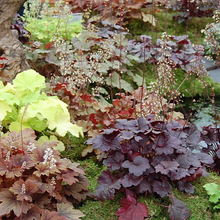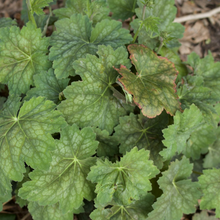Heuchera americana is a native woodland perennial valued for its attractive foliage that ranges from deep green to marbled patterns of burgundy, silver, and purple. While its small bell shaped flowers are subtle, they rise above the leaves in airy sprays adding delicate texture in early summer. Its evergreen presence and tolerance for dry shade make it a staple in naturalistic plantings, shaded borders, and woodland gardens.
Height & Spread: 12 - 18 in x 12 - 18 in
Bloom Time: Late spring to early summer
Light Requirements: Part shade to full shade
Soil Preference: Prefers humus rich, well drained soil
Watering Needs: Low to moderate once established
Deer Resistance: Foliage is typically avoided by deer and rabbits
Native Status
This species is native to eastern North America where it grows in rich deciduous forests and rocky slopes. It is commonly found from Minnesota to Georgia and eastward to the Atlantic coast.
WILDLIFE & INSECTS
Bees
- The small flowers attract native bees such as sweat bees (Halictidae) and mining bees (Andrena) looking for nectar and pollen in spring and early summer.
Moths
- Serves as a larval host for several moth species including the wavy lined emerald and common pug moths.
Birds
- Provides low cover and foraging habitat for ground feeding birds like thrushes and sparrows in woodland settings.
Spacing & Landscape Use
Spacing Recommendations:
- Space 12 - 18 in apart to form a dense ground hugging mass or blend into mixed shade plantings.
Landscape Placement:
- Ideal for shady edges, native woodland gardens, beneath shrubs, or as edging in part shaded perennial borders. Blends well with spring ephemerals and evergreen companions.
Companion Plants
- Polygonatum biflorum (Solomons Seal) - Graceful arching stems with white flowers contrast with the bold foliage of Heuchera.
- Asarum canadense (Wild Ginger) - Broad low leaves provide an effective contrast and share similar native habitat preferences.
- Carex pensylvanica - This fine textured sedge complements the rounded leaves of Heuchera while thriving in the same dry shade conditions.
- Tiarella cordifolia - Foamy white blooms and lobed foliage create a soft visual pairing in woodland gardens.
- Stylophorum diphyllum (Wood Poppy) - Bright yellow spring flowers pop against Heuchera’s darker leaves for seasonal contrast.



